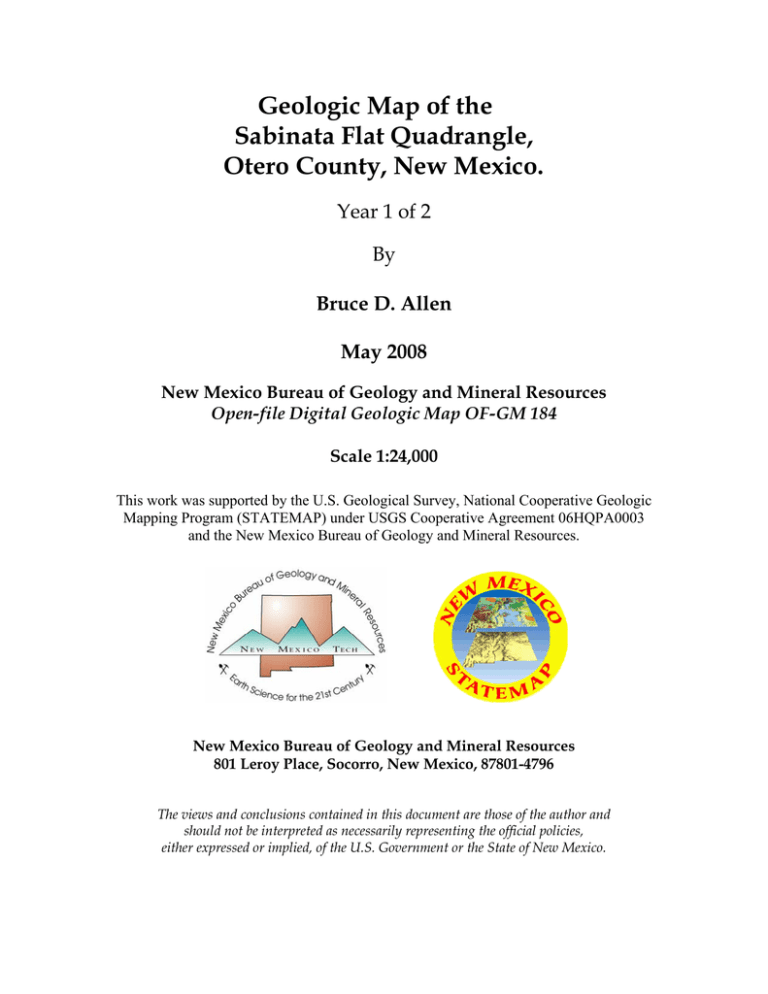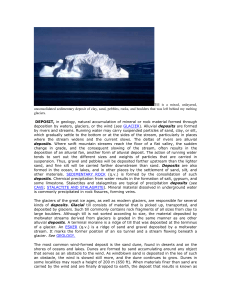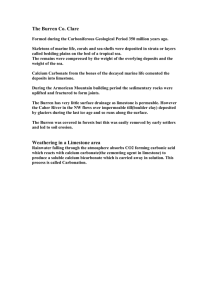Geologic Map of the Sabinata Flat Quadrangle, Otero County, New Mexico.
advertisement

Geologic Map of the Sabinata Flat Quadrangle, Otero County, New Mexico. Year 1 of 2 By Bruce D. Allen May 2008 New Mexico Bureau of Geology and Mineral Resources Open-file Digital Geologic Map OF-GM 184 Scale 1:24,000 This work was supported by the U.S. Geological Survey, National Cooperative Geologic Mapping Program (STATEMAP) under USGS Cooperative Agreement 06HQPA0003 and the New Mexico Bureau of Geology and Mineral Resources. New Mexico Bureau of Geology and Mineral Resources 801 Leroy Place, Socorro, New Mexico, 87801-4796 The views and conclusions contained in this document are those of the author and should not be interpreted as necessarily representing the official policies, either expressed or implied, of the U.S. Government or the State of New Mexico. Description of Map Units, Sabinata Flat 7.5' Quadrangle Quaternary Map Units Undifferentiated Quaternary deposits and artificially disturbed areas. af Artificially modified areas. Historic. Dumped fill and excavated areas, including highways, gravel pits, and earth dams in drainages. Qac Undivided alluvium and colluvium. Holocene to Middle Pleistocene (?). Silt, sand, gravel and clay in various proportions, generally unconsolidated, deposited in a variety of depositional settings. On the mountain block east of the Alamogordo fault zone unit is mapped on hillslopes and in drainages underlain by older alluvium and bedrock, and interfingers with younger piedmont alluvium (map unit Qpy) along drainage foot slopes. Thickness in these areas is generally 5 m or less. In the vicinity of the Alamogordo fault, unit is mapped where it forms a thin (generally less than 2 m) cover over older alluvial deposits, bedrock, and fault scarps. Older deposits exhibit strong accumulation of pedogenic gypsum and calcium carbonate, and at some localities (typically where the unit overlies bedrock) are cemented with calcium carbonate probably derived from shallow groundwater. Unit also includes stripped remnants of differentiated piedmont alluvium and small, unmapped areas of bedrock. Piedmont alluvial deposits (map area east of the Alamogordo fault zone). The area between the Alamogordo fault on the west extending to the eastern edge of the map is technically part of the mountain block of the Sacramento Mountains. However, as discussed by Pray (1961), the outcrop belt of the Yeso Formation in much of the Sacramento Mountains typically coincides with a major ~north-south trending topographic escarpment that in places exhibits nearly as much relief as the topographic/structural (mountain-front) escarpment to the west. Pray (1961) refers to the area between the two escarpments as the Ranchario "pediment" (see, for example, p. 119 and Fig. 4 in Pray, 1961). Quaternary map units in this area are divided into older, intermediate, and younger "piedmont" alluvial units, "piedmont" referring to areas downgradient from the Yeso topographic escarpment, rather than areas down-gradient from the structural mountain front. Qpy Younger piedmont alluvium. Holocene to Upper Pleistocene (?). Silt, sand and clay with locally abundant pebble to boulder gravel. Coarse-grained clasts (gravel and boulders) are more common in areas proximal to the topographic escarpment along the eastern edge of the map area. Unit is commonly dissected by incised channels (arroyos) and is generally a few meters thick or less, but exposures up to 10 m thick are present in some arroyo cuts. Over most of the map area, unit is generally structureless, pale reddish brown, and fine grained (silt, sand, and clay), exhibits little soil development, and contains thin, discontinuous beds of clastsupported, angular to subrounded gravels consisting largely of Permian sedimentary clasts (predominately limestone). Qpi Intermediate piedmont alluvium. Upper to Middle (?) Pleistocene. Pebbly to cobbly sand, silt, and clay. Coarse-grained clasts are more common in areas proximal to the topographic escarpment along the eastern edge of the map area. Upper planar surfaces of unit are commonly gravely lags, and range from one to several meters above active drainages. Deposits are weakly dissected to extensively stripped, depending on locality. Alluvial-fan morphology is preserved in proximal piedmont landscape positions along eastern side of map area; in other areas unit consists of terrace remnants along margins of modern valleys, or is partially to nearly completely buried by younger piedmont alluvium within valleys. Probably represents more than one episode of alluvial aggradation, and a few areas shown as Qpi may in fact represent erosional terraces (straths) with a thin cover of alluvium, rather than major aggradational events. Unit commonly exhibits pedogenic accumulation of gypsum a few decimeters below the surface. In areas where the deposit has been stripped, pedogenic gypsum horizons have been exposed and weathered to form a hard gypsum crust at the surface. Unit is also mapped in Laborcita Canyon just to the east of the mountain front, where terrace deposits (on bedrock) are present up to 15 m above the floor of the drainage. This correlation is speculative. Generally less than 5 m thick. Qpo Older piedmont alluvium. Middle to Lower (?) Pleistocene. Consisting primarily of poorly sorted silty sand and gravely sand to gravel, unit is preserved on higher interfluves where it lies on top of bedrock. Gravel clasts are primarily Paleozoic limestone. The strath surface at the base of the unit is up to tens of meters above modern drainages. This basal contact with underlying bedrock is commonly concealed by colluvium. Unit has been extensively dissected and stripped, and the eroded upper surface typically consist of a thick lag of subrounded limestone pebbles and cobbles. Basal few meters of the unit, where exposed, is commonly cemented with calcite, probably related to precipitation of calcium carbonate from groundwater. Artificial exposures (cuts along dirt roads) reveal stage III and greater pedogenic carbonate development. Deposits are up to ~20 m thick. Valley-fill deposits, terraces and valley-border areas along Rio Tularosa Qtt Valley-fill deposits and terraces. Holocene to Upper Pleistocene (?). Fluvial sand, silt, clay, and gravel in the immediate vicinity of Rio Tularosa just north of Highway 70 and east of the mountain front. These deposits have been incised by the stream during the late Holocene, and underlie terrace surfaces that are several meters above, and extend laterally up to a hundred meters or more on either side of, the modern floor of the drainage. Time did not permit detailed examination of the deposits, which consist of a variety of thinly to thickly interbedded lithofacies, dominated by pale reddish brown silty sand and pale-colored gypsiferous silt and sand, with probable weakly developed buried soil horizons. These stratified fluvial/floodplain deposits probably contain an abundance of material suitable for radiocarbon dating as well as fossil floral and faunal remains, making them a likely candidate for future studies focused on reconstructing episodes of Holocene fluvial aggradation and incision in this part of the Tularosa Basin. Qtb Valley-border alluvium and erosional surfaces. Holocene to Upper Pleistocene. A composite unit mapped in the vicinity of Rio Tularosa that includes fluvial deposits of the trunk stream and younger alluvium and colluvium derived from lateral transport of sediment from immediately surrounding areas or carried in from tributary valleys, as well as erosional surfaces developed on older piedmont alluvial deposits and small areas of unmapped bedrock. Unit Qtt described above is inset into this geologically complex depositional/erosional map unit, which could be subdivided into a variety of depositional units and geomorphic surfaces (and underlying deposits) with detailed mapping at a larger scale. Alluvial fans (map area west of the Alamogordo fault zone) Detailed mapping of the alluvial fans west of the Alamogordo fault zone, including Quaternary faults (with scarps) along the mountain front was conducted by Koning and Frechette. For the purposes of this compilation, their dozen or so original map units (including detailed map-unit descriptions) were simplified into the four basic units and descriptions summarized below. For instance, surface deposits on the alluvial fans west of the mountain front are predominately of Holocene age, as determined by radiocarbon chronology of correlative deposits in nearby areas and the degree of soil and desert pavement development (see, for example, Koning, 1999 and Koning et al., 2002). These deposits can be subdivided based on a variety of criteria including age, lithology and surface characteristics. Here, the Holocene alluvial fan deposits are lumped into a single unit (map unit Qpy), comprising a few sub-units. For example, in proximal areas the Holocene fan deposits are generally coarser grained sand and gravely sand (sub-unit Qpyc), which grade distally into finer grained deposits (sub-unit Qpyf). Qam Alluvium in modern drainages. Uppermost Holocene. Sand and gravel deposited in drainages subject to recent fluvial activity. Bar and swale topography typically present, with as much as 50 cm of relief. Gravel is subrounded, poorly sorted, dominated by limestone clasts, and includes pebbles to boulders. Sand is fine- to coarse-grained, subangular to subrounded and poorly to moderately sorted. Probably less than 2 m thick. Qif Alluvium and colluvium in interfan areas adjacent to the mountain front. Holocene. Map unit encompasses triangular-shaped areas between major drainages that are covered by a thin veneer of silty sand to gravely sand which includes, in some areas, likely contributions of eolian silt. Unit overlies older alluvial deposits along the mountain front and likely includes unmapped areas of Qpy and Qpo. However, for cartographic simplicity and because of their relatively small size, these interfan areas are assigned here to this single map unit. Deposits range from a few tens of centimeters to perhaps 2 m in thickness. Qfy Younger alluvial fan deposits. Holocene. Sand, silt, gravel and clay deposited on alluvial fans west of the mountain front. Individual fans exhibit typical, coneshaped alluvial fan morphology, and coalesce a km or less to the west of the mountain front to form an alluvial apron that slopes westward toward the floor of the Tularosa Basin. In this compilation the Holocene fan deposits are divided into proximal "coarse-grained" and distal "fine-grained" deposits (map units Qfyc and Qfyf), based largely on interpretations from aerial photographs. Some areas that appear to consist of "coarse-grained" deposits based on surface characteristics may represent relatively fine-grained deposits overlain by a thin gravel lag resulting from winnowing of fine-grained sediment from surfaces by sheet-wash and perhaps eolian processes. Two lobes of very young alluvium, also inferred from aerial photography, are present as well (map unit Qfyh). The large fan that emanates from the mouth of Rio Tularosa at the mountain front (near Highway 70) is mapped as Qfy (undifferentiated), because extensive cultural modification (i.e., agricultural activity) has obscured the surface characteristics of these deposits in that area. Qfyh Very young Qfy alluvium. Uppermost Holocene. Mapped in two areas where fluvial morphology can be seen on the surface using aerial photographs. In the proximal part of the alluvial fan, this sediment is similar to Qam but bar and swale topography is muted and there is no evidence of significant fluvial activity in recent time. In the distal part of the alluvial fan, this unit is applied to thin sheet-flood deposits overlying unit Qfyf that consist of planar- to cross-laminated light brown silt and fine-grained sand. Upper surface exhibits subtle scouring or possible bar forms. No observable soil development, desert pavement or clast varnish. Generally less than 2 m thick in the proximal alluvial fan, thinning to less than 20 cm in distal areas. Qfyc Coarser-grained Qfy alluvial fan deposits. Holocene. Light to dark reddish brown and brown to pink silty pebbly sand to sandy gravel. Gravels are predominately pebbles, with minor cobbles, subrounded, poorly sorted, and composed of Paleozoic limestone with some clasts of Paleozoic sandstone-siltstone and Tertiary intrusives. Sand is fine- to coarse-grained and poorly sorted. Surface has slight bar and swale relief of 10-30 cm. Its desert pavement has weak to no clast armor and little varnish. Surface soils contain accumulations of gypsum (similar in development to a stage I to II calcic soil horizon). Unit is generally 1 to 4 m thick. Qfyf Finer-grained Qfy alluvial fan deposits. Holocene. Light reddish brown and brown to pink silty to clayey sand. Sand is fine- to coarse-grained and moderately to poorly sorted. In proximal to medial fan areas buried lenses of pebbles and pebbly sand, up to 1 m thick, are also present. Bar and swale topography, as well as desert pavement and soil development are similar to that of unit Qfyc above. Unit is generally 1 to 4 m thick. Qfo Older alluvial fan deposits. Upper to Middle (?) Pleistocene. Gravely sand and silty sand interbedded with clast-supported, sandy pebble to cobble gravels. Gravel beds are 10 to 50 cm thick and lenticular. Sandy beds are tabular and generally structureless, typically reddish brown, and are fine- to coarse-grained and moderately to poorly sorted. Unit is recognized by its topographically high smooth surface (lacks bar and swale topography), and is inset by younger deposits of unit Qfy. Surfaces exhibit a weakly to moderately developed pavement of well-varnished clasts. Surface soils are characterized by a stage II to III calcic to gypsic horizon. Bottom of unit was not defined (and therefore not observed) in the map area. Greater than 8 m thick. Bedrock Map Units Igneous Rocks (Paleogene) An Eocene age assignment for the igneous intrusive rocks in the map area is inferred from McManus and McMillan's (2002) investigation of igneous intrusions in the Sacramento Mountains. Tid Fine-grained, dark-colored, vertical to sub-vertical dikes. Eocene (?). Generally forms north-northeast trending, resistant linear ridges intruding upper Paleozoic sedimentary rock; identified and mapped for the most part based on aerial photographs. Examination of samples from a few outcrops indicate mm- to submm-scale feldspar, specks of magnetite (?), and in some samples mm-scale blocky calcite in a dark colored, fine-grained groundmass. Up to a few meters in width. Tis Pale-colored fine-grained and greenish gray porphyritic tabular sills. Eocene (?). The largest sill intrudes the Permian Bursum Formation in the vicinity of Domingo Canyon near the frontal escarpment and extends southward to the southern edge of the map area and beyond. Another sill is present in the Permian Abo Formation along the north-central edge of the map area. The large sill extending southward from Domingo Canyon is up to 50 m thick, with many local apophyses, and consists of mm-scale, equigranular plagioclase feldspar with locally abundant mm-scale biotite. The sill in the north-central part of the map area is porphyritic, consisting of plagioclase and biotite phenocrysts in an altered, greenish gray groundmass. Additional thin, unmapped intrusions are present in the northwest corner of the map area. Sedimentary Rocks (Upper Paleozoic) Py Yeso Formation. Lower Permian. Red and yellow mudstone, siltstone and lesser sandstone with beds of gypsiferous mudstone, thinly bedded gray limestone and laminated gypsum. Gypsiferous beds are relatively abundant in the lower part of the formation. Some limestone beds contain an abundance of fossil gastropods, brachiopods, and assorted micro-invertebrates. Deposited in restricted marine to marginal marine settings. Base of unit where exposed in the map area is reddish orange gypsiferous siltstone and mudstone and overlying mudstone and sandy siltsone typical of the Abo Formation. Top of unit is not present in the map area. Exposures of the Yeso in the map area are generally very poor, with a thin to thick cover of colluvium and regolith. Total thickness of the unit is estimated to be on the order of 365 m (Otte, 1959). Pa Abo Formation. Lower Permian. Red mudstone, siltstone, and sandstone with conglomerate and minor limestone beds in the lower part of the section. Nodular limestone beds that may represent ancient accumulations of pedogenic carbonate are also present. Mudstone and siltstone are the dominant lithologies. The bulk of the Abo Formation was deposited in a terrestrial alluvial environment. The base of the formation south of Domingo Canyon has been assigned by Otte (1959) to thick beds of cobble conglomerate containing Proterozoic quartzite and rhyolitic porphyry clasts. North of Rio Tularosa Otte chose the base of the Abo at the top of a fossiliferous, fusulinid-bearing marine limestone bed (assigned to the top of the Bursum Formation) that continues laterally several kilometers to the north beyond the map area. An attempt has been made to follow Otte's picks for the base of the Abo in this compilation, although it is noted that in some areas lithologies are present (including thin beds of fossiliferous marine limestone) above Otte's pick for the base of the unit that are more similar to underlying deposits of the Bursum formation than the mudstones, siltstones and sandstones of the main body of the Abo. The top of the formation, although poorly exposed in the map area, is a comparatively abrupt transition from brick red siliciclastics characteristic of the Abo Formation to gypsiferous, reddish orange mudstones of the Yeso Formation. Estimated to range from 120 to 425 m thick in the map area (Otte, 1959). Pb Bursum Formation. Lower Permian to Upper Pennsylvanian. Variously colored but predominantly reddish to greenish sandstone, siltstone and mudstone, interbedded with lesser amounts of marine limestone and dark-colored marine shale. Also contains beds of conglomerate, up to several meters thick, containing pebble- to cobble-sized quartzite and rhyolitic porphory clasts, as well as conglomeratic beds dominated by limestone clasts. Algal bioherms are present in the northwestern part of the map area that have been studied in some detail (e.g., Scholle et al., 2007). The unit represents the transition from predominantly marine conditions that existed during deposition of the underlying Pennsylvanian Holder Formation, to a terrestrial environment during deposition of the overlying Permian Abo Formation. Otte (1959) proposed the name Laborcita Formation for these transitional deposits in the map area, and that name has persisted in the scientific literature for decades. Lucas and Krainer (2004), based on regional study of these transition beds, have concluded that the deposits belong in the Bursum Formation (the name "Laborcita" may be retained as a member of the Bursum Formation in the northern Sacramento Mountains). The age assignment for the Bursum Formation is also undergoing continued discussion (S.G. Lucas, personal communication, 2009). Based on North American fusulinid biostratigraphy, the bulk of the Bursum in the Sacramento Mountains is Wolfcampian, traditionally considered to be Lower Permian. Recent biostratigraphic studies based on conodonts, however, suggest that lowermost Wolfcampian strata in North America may ultimately be considered Upper Carboniferous in the global scheme. At any rate, the lithostratigraphic base of the formation in the map area is gradational with the underlying Holder Formation, and is chosen at the top of a laterally continuous, comparatively thick bed of marine limestone (assigned to the top of the Pennsylvanian Holder Formation), the basal Bursum deposits consisting of a succession of reddish and greenish siltstone and sandstone with interbeds of limestone and locally a bed of limestone conglomerate near the base of the formation. The top of the formation is also gradational over a few tens of meters with the overlying Abo Formation, as discussed above in the description of that unit. Estimated to range from about 170 to 300 m thick, thickening from south to north across the map area (Otte, 1959). IPh Holder Formation. Upper Pennsylvanian. Interbedded dark-colored marine shale and fossiliferous limestone containing beds of sandstone, reddish to maroon mudstone, and occasional beds of limestone conglomerate. Deposited for the most part in a marine environment. The base of the formation is not exposed in the map area. As discussed above, the top of the Holder is gradational with the overlying Bursum Formation in the map area. Estimated to be about 275 m thick just south of the map area (Otte, 1959). Unexposed Sedimentary Rocks Underlying the Map Area (Depicted on the Cross Section) Because of significant regional variations in stratigraphy and structure and a paucity of subsurface information in the immediate map area, the thickness and lateral distribution of older Paleozoic bedrock units that underlie the area is uncertain. Therefore, the older sedimentary rock units on the cross section are not differentiated, and the thickness (or even the presence) of specific formations along the cross section are speculative. Similarly, the thickness of the Neogene basin fill west of the Alamogordo fault zone is poorly constrained (estimated from gravity data to be 1000 m thick or more; see King and Harder, 1985. p. 28). Descriptions, discussions and literature citations of the Paleozoic rock units in the greater Sacramento Mountains area are presented by Pray (1961), King and Harder (1985), and Raatz (2002). Rock units exposed in the Sacramento Mountains just to the south of the map area are summarized below, along with estimated thicknesses used to construct the cross section. QTb Neogene. Basin-fill deposits of the Tularosa Basin west of the Alamogordo fault zone. Greater than 1000 m. IP Pennsylvanian. Marine limestone, shale, and sandstone. Includes, in ascending order, the Gobbler, Beeman and Holder Formations (the Holder Formation is the oldest rock unit exposed in the map area). 800 m. The Paleozoic strata listed below are combined on the cross section. Mississippian. Marine limestone and shale. Includes the Lake Valley Formation and perhaps the underlying Caballero Formation. 30 m. Devonian. Marine shale, dolomite, sandstone and limestone. Includes, in ascending order, the Onate, Sly Gap, and Percha Shale Formations. 45 m. Silurian. Marine dolomite of the Fusselman Formation. 30 m. Ordivician. Marine dolomite and minor siliciclastic sand. May include, in ascending order, the Bliss Sandstone (Cambrian-Ordivician), El Paso, Montoya, and Valmont Dolomite Formations. 180 m. X Proterozoic. Undifferentiated metamorphic and/or igneous crystalline-basement rocks. References Cited King, W.E., and Harder, V.M., 1985, Oil and gas potential of the Tularosa Basin-Otero Platform-Salt Basin graben area, New Mexico and Texas: New Mexico Bureau of Mines and Mineral Resources, Circular 198, 36 p. (with plates). Koning, D.J., 1999, Fault segmentation and paleoseismicity of the southern Alamogordo fault, southern Rio Grande rift [M.S. thesis]: Albuquerque, University of New Mexico, 286 p. Koning, D.J., Pazzaglia, F., and Smartt, R., 2002, Alluvial fan stratigraphy along the southern Sacramento Mountains, N.M., and inferences regarding late Quaternary plaeoclimate, soils, and sedimentation: New Mexico Geological Society, 53rd Field Conference Guidebook, p. 289-302. McManus, C.E.D., and McMillan, N.J., 2002, Subduction or rifting: the Eocene magmas of the Sacramento Mountains, NM: Geological Society of America Abstracts with Programs, v. 34, p. 364. Otte, C., 1959, Late Pennsylvanian and early Permian stratigraphy of the northern Sacramento Mountains, Otero County, New Mexico: New Mexico Bureau of Mines and Mineral Resources, Bulletin 50, 111 p. (with plates). Pray, L.C., 1961, Geology of the Sacramento Mountains escarpment, Otero County, New Mexico: New Mexico Bureau of Mines and Mineral Resources, Bulletin 35, 144 p. (with plates). Raatz, W.D., 2002, A stratigraphic history of the Tularosa basin area, south-central New Mexico: New Mexico Geological Society, 53rd Field Conference Guidebook, p. 141157. Scholle, P.A., Goldstein, R.H., and Ulmer-Scholle, D.S., 2007, Classic Upper Paleozoic reefs and bioherms of west Texas and New Mexico: New Mexico Bureau of Geology and Mineral Resources, Open-file Report 504, 174 p.







